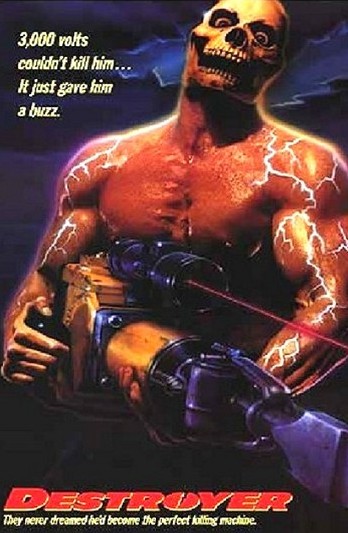Sunday, September 18, 1988.
DESTROYER. Written by Peter Garrity, Rex Hauck and Mark W. Rosenbaum. Directed by Robert Kirk. Running time: 94 minutes. Restricted entertainment with the B.C. Classifier's warning: frequent violence, very coarse language, occasional nudity.
Reviewed with:
BLINDSIDE. Written by Richard Beattie. Music by Paul Zaza. Directed by Paul Lynch. Running time: 98 minutes. Restricted entertainment with the B.C. Classifier's warning: some violence, nudity and suggestive scenes.
HERO AND THE TERROR. Written by Dennis Shryack and Michael Blodgett, based on Blodgett’s 1982 novel. Directed by William Tannen. Running time: 96 minutes. Rated 14 Years Limited Admission with the B.C. Classifier’s warning: some violence, some very coarse language.
A NIGHTMARE ON ELM STREET 4: THE DREAM MASTER. Written by Brian Helgeland and Scott Pierce. Music by Craig Safan. Directed by Renny Harlin. Running time: 93 minutes. Restricted entertainment with the B.C. Classifier's warning: frequent gory violence, occasional nudity and very coarse language.
THE DEATH TOLL IS ENORMOUS. In just four features, some 34 lives are snuffed out in graphic detail episodes for the delectation of filmgoers.
The guilt felt by the guilty is nil. In three of the four pictures, the villain is a serial killer with powers bordering on the supernatural.
The Destroyer is Ivan Moser (Lyle Alzado), convicted slayer of 22, who survived the electric chair. Described as “half-alive,” this massively muscled behemoth lurks about an abandoned state prison awaiting fresh prey.
"Terror" Simon Moon (Jack O’Halloran), did away with 23 before being committed to a facility for the criminally insane. A hulk with “no thought processes,” he escapes to kill again in Hero and the Terror.
Freddy Krueger (Robert Englund), the dream demon who specializes in teen terminations, has a rap sheet going back three films. "I am eternal!’’ he boasts to 17-year-old Alice Johnson (Lisa Wilcox) in A Nightmare on Elm Street 4: The Dream Master.
Only Blindside, director Paul Lynch’s dull, Canadian-made thriller, offers reasonably mortal villains. A low-rent reprise of Francis Ford Coppola’s The Conversation (1974), Lynch's picture features Harvey Keitel as Penfield Gruber, a morose professional snoop caught in a web of gangland betrayal and assassination.
In common with Krueger, Moon and Moser, Lynch’s killers are uniformly amoral and without conscience as they “whack” one another with maniacal glee. The mood of the film, though, is utterly gloomy, reflecting the depressed Gruber’s conviction that people are awful.
Since Blindside's bad guys are all drug dealers, it's possible to read into their ends a minor moral lesson. By contrast, the other movies' villains deal exclusively in death.
Despite the relentless pursuit of soulful rogue cop Dan O'Brien (Chuck Norris), the deranged Moon gets to snap a selection of (mostly female) necks before he faces down the hero.
Moser manages to wipe out most of an exploitation film crew working on location in his prison hideout. Krueger, adding gallows humour to his repertoire, continues to deplete Springwood’s adolescent population.
Worth noting, perhaps, is the fact that both Moser and Krueger are bested by self-reliant female characters. (Deborah Foreman’s Susan Malone in Destroyer; Wilcox’s Johnson in Nightmare 4).
As welcome as this is as a film trend, it’s overshadowed by the realization that these movies are offering mass murder as entertainment. Taken individually or together, this stuff is sick.
The above is a restored version of a Province review by Michael Walsh originally published in 1988. For additional information on this archived material, please visit my FAQ.
Afterword: It hardly seemed safe to set foot on Vancouver’s Theatre Row during the first week of autumn, 1988. Mass murderers lurked in almost every movie house, it seemed. Overwhelmed, I offered up the above package review expressing my disappointment with the lot. If I’d written a full review of Destroyer, I would have focused on the writing team’s attempt to have some fun with the idea of exploitation filmmaking. The mayhem starts when basement-budget movie director Robert Edwards (Anthony Perkins) sets up shop in amped-up serial killer Ivan Moser’s hideaway, chosen as the set for a women’s prison picture called Death House Dollies.
I know that my younger self would have offered a brief history of that sweaty cinema sub-genre that took off in the 1980s with such features as The Concrete Jungle (1982), Chained Heat (1983), Caged Women (1984), Red Heat (1985) and Bad Girls Dormitory (1986). Along the way, I would have praised Deborah Foreman’s performance as no-nonsense stuntwoman Susan Malone, the real hero of the story.
The California-born actress was an attractive young talent who never got the breaks she deserved. She demonstrated her ability to steal the show in her first feature starring role, as Julie Richman, the title character in director Martha Coolidge’s 1983 rom-com Valley Girl. Despite good reviews, she became stereotyped as a “scream queen,” and her career stalled in that low-budget cinema cellar, making movies such as Destroyer. She called it quits at the age of 28, after the release of her 14th feature, the 1991 psycho-noir epic Lunatics: A Love Story.
